最新自然拼读Unit1教案
小学英语自然拼读法Phonics教学教案

小学英语自然拼读法Phonics教学教案第一章:引言1.1 教学目标让学生了解自然拼读法的基本概念。
使学生认识到自然拼读法在英语学习中的重要性。
1.2 教学内容自然拼读法的定义与原理。
自然拼读法在英语教学中的应用。
1.3 教学方法讲授法:讲解自然拼读法的概念与原理。
互动法:引导学生参与课堂讨论,分享学习经验。
第二章:元音字母教学2.1 教学目标让学生掌握元音字母的发音规则。
使学生能够正确拼读含有元音字母的单词。
2.2 教学内容元音字母的发音特点。
元音字母的拼读练习。
2.3 教学方法演示法:教师展示元音字母的发音特点。
练习法:学生进行元音字母的拼读练习。
第三章:辅音字母教学3.1 教学目标让学生掌握辅音字母的发音规则。
使学生能够正确拼读含有辅音字母的单词。
3.2 教学内容辅音字母的发音特点。
辅音字母的拼读练习。
3.3 教学方法演示法:教师展示辅音字母的发音特点。
练习法:学生进行辅音字母的拼读练习。
第四章:元音字母组合教学4.1 教学目标让学生掌握元音字母组合的发音规则。
使学生能够正确拼读含有元音字母组合的单词。
4.2 教学内容元音字母组合的发音特点。
元音字母组合的拼读练习。
4.3 教学方法演示法:教师展示元音字母组合的发音特点。
练习法:学生进行元音字母组合的拼读练习。
第五章:辅音字母组合教学5.1 教学目标让学生掌握辅音字母组合的发音规则。
使学生能够正确拼读含有辅音字母组合的单词。
5.2 教学内容辅音字母组合的发音特点。
辅音字母组合的拼读练习。
5.3 教学方法演示法:教师展示辅音字母组合的发音特点。
练习法:学生进行辅音字母组合的拼读练习。
第六章:简单的单词拼读练习6.1 教学目标让学生能够将学到的元音字母、辅音字母及字母组合应用于简单单词的拼读。
提高学生对英语单词的识别和理解能力。
6.2 教学内容设计一系列简单单词的拼读练习,涵盖元音字母、辅音字母及字母组合。
引导学生通过拼读练习,理解单词的意义。
自然拼读教案(终极)

自然拼读教案(终极)章节一:引言教学目标:1. 让学生了解自然拼读的概念和重要性。
2. 培养学生对自然拼读的兴趣和好奇心。
教学内容:1. 自然拼读的定义和原理。
2. 自然拼读的优势和应用。
3. 自然拼读的基本步骤和技巧。
教学活动:1. 引入自然拼读的概念,让学生初步了解。
2. 通过实例和案例,让学生感受自然拼读的优势和实用性。
3. 引导学生思考自然拼读的原理和步骤。
章节二:字母和音素教学目标:1. 让学生掌握字母表和基本音素。
2. 培养学生对字母和音素的认知和理解。
教学内容:1. 字母表的排列和发音规则。
2. 音素的定义和分类。
3. 字母和音素的关系。
教学活动:1. 教授字母表的排列和发音规则。
2. 介绍音素的定义和分类。
3. 通过实例和练习,让学生理解和掌握字母和音素的关系。
章节三:拼读和发音教学目标:1. 让学生掌握拼读的技巧和方法。
2. 培养学生正确发音的能力。
教学内容:1. 拼读的定义和原理。
2. 发音的规则和技巧。
3. 拼读和发音的实践应用。
教学活动:1. 介绍拼读的定义和原理。
2. 教授发音的规则和技巧。
3. 通过练习和互动,让学生熟练掌握拼读和发音的技巧和方法。
章节四:词汇和句子教学目标:1. 让学生能够运用自然拼读读写词汇和句子。
2. 培养学生的词汇量和语言表达能力。
教学内容:1. 词汇的拼读和书写。
2. 句子的结构和语法。
3. 词汇和句子的实际应用。
教学活动:1. 教授词汇的拼读和书写。
2. 介绍句子的结构和语法。
3. 通过练习和互动,让学生能够运用自然拼读读写词汇和句子,并培养词汇量和语言表达能力。
章节五:阅读和写作教学目标:1. 让学生掌握阅读和写作的基本技巧。
2. 培养学生的阅读兴趣和写作能力。
教学内容:1. 阅读的理解和分析。
2. 写作的构思和表达。
3. 阅读和写作的实际应用。
教学活动:1. 教授阅读的理解和分析技巧。
2. 介绍写作的构思和表达方法。
3. 通过阅读和写作的练习和互动,让学生熟练掌握阅读和写作的技巧,并培养阅读兴趣和写作能力。
自然拼读教案第一讲讲解学习

自然拼读教案第一讲自然拼读教案第一讲教学内容:热身运动自我介绍(教师自我介绍,和孩子打招呼)引入(介绍什么是自然拼读以及其重要性)学习26个字母的发音布置作业教学重点:26个字母的发音课前准备:了解孩子们的名字,避免询问孩子名字时因听不清楚发生尴尬的事情;字母卡(顺序排列好,分为元音和辅音);学习元音需要用到的图片;粘贴磁;课堂上的补充资料;(打印多2份)糖果教学流程:一、热身运动第一节课教师和孩子们见面,最终的任务就是让孩子对你和你的课堂感兴趣,这样也会使之后的教学更加顺利。
教师自我介绍前不妨和孩子们玩个幼儿英语课前热身游戏,调动一下课堂的气氛,让孩子们以良好状态下步入英语课堂。
(以下是Fairy老师今天准备的热身游戏:Shake your body.注意:多用简单的英语指令,教师要尽量活跃一点,把课堂气氛调动起来)T: Good afternoon! boys and girls!Before we begin our class, let’s do a warm-up practice together. Now all students stand up please. (教师此时要手示意全班起立) Follow me!Shake your shoulders, shua shua shua (上下抖动肩膀)Shake your hands ,clap clap clap (甩甩手,拍三下)Shake your hip ,pia pia pia (扭扭屁股,打三下)Shake your feet ,dong dong dong (抖抖脚,跺三下)(第一遍孩子跟着老师做,速度放慢,让孩子能够跟得上。
第二遍老师的指示口令速度加快,让孩子自己做,若孩子没有反应过来,老师可以动作提示。
)T: You all did a good job! (老师竖起大拇指) Sit down please!(老师示意孩子们坐下)二.自我介绍(教师自我介绍,和孩子打招呼)教师要用自己独特的介绍自己让孩子们记住自己的名字。
小学一自然拼读教案

小学一自然拼读教案【教案】小学一自然拼读教案篇一:音素拼读法教学设计教学目标:1. 掌握自然拼读法的基本原理和方法;2. 认识并掌握英语字母及音素的发音规则;3. 能够正确拼读和辨认单词。
教学重难点:1. 学生理解自然拼读法的思想;2. 学生掌握英语音素和对应的发音规则;3. 学生能够运用所学知识正确拼读单词。
教学准备:1. 老师准备课件、图片和单词卡片;2. 学生准备课本和练习册。
教学过程:Step 1:导入(5分钟)1. 师生互动,复习上一节课所学内容。
2. 通过问答的方式,引导学生思考拼读单词的基本规则。
3. 引出自然拼读法的概念和作用。
Step 2:理论讲解(10分钟)1. 利用课件和图片,介绍英文字母及其对应的音素发音规则。
2. 讲解自然拼读法的基本原理和方法,包括字母组合的规则和特殊发音的情况。
Step 3:示范与练习(15分钟)1. 老师示范如何根据音素拼读单词,并加以解释。
2. 学生跟读示范,通过课本和练习册上的例子进行练习。
Step 4:巩固与展示(15分钟)1. 学生分组进行对拼读练习,组内相互帮助和纠正。
2. 挑选几位学生展示练习的成果,并给予个别评价。
Step 5:应用与拓展(15分钟)1. 学生个别或小组完成教师布置的课后作业,巩固拼读技巧。
2. 鼓励学生在课外积极应用所学知识,如阅读英文文章或跟读英文电影对话。
Step 6:反思与总结(5分钟)1. 教师与学生一起回顾本节课所学内容。
2. 学生针对自己的拼读问题进行反思和总结,提出改进建议。
篇二:拼读教学设计案例教学目标:1. 认识元音字母及其发音规则;2. 学会通过音素拼读法正确拼读和辨认单词;3. 能够运用所学知识将音素组合成单词。
教学重难点:1. 学生理解元音字母的特点和发音规则;2. 学生能够准确拼读和辨认单词;3. 学生运用所学知识组合元音字母并拼读。
教学准备:1. 老师准备音标表、练习册和黑板;2. 学生准备课本和笔。
小学英语自然拼读法Phonics教学教案
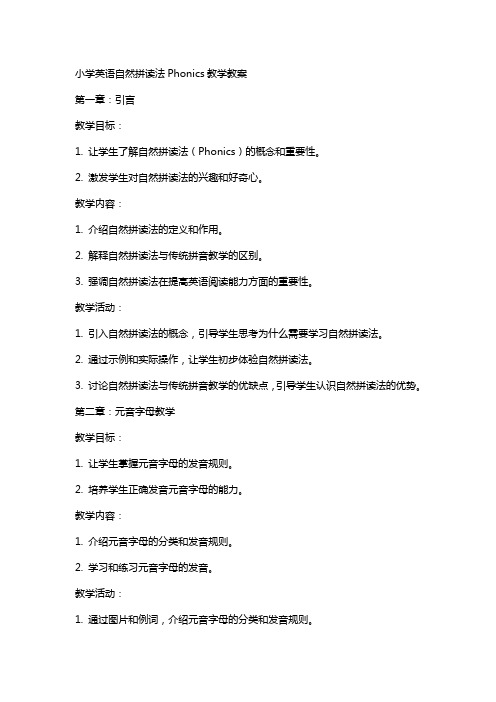
小学英语自然拼读法Phonics教学教案第一章:引言教学目标:1. 让学生了解自然拼读法(Phonics)的概念和重要性。
2. 激发学生对自然拼读法的兴趣和好奇心。
教学内容:1. 介绍自然拼读法的定义和作用。
2. 解释自然拼读法与传统拼音教学的区别。
3. 强调自然拼读法在提高英语阅读能力方面的重要性。
教学活动:1. 引入自然拼读法的概念,引导学生思考为什么需要学习自然拼读法。
2. 通过示例和实际操作,让学生初步体验自然拼读法。
3. 讨论自然拼读法与传统拼音教学的优缺点,引导学生认识自然拼读法的优势。
第二章:元音字母教学教学目标:1. 让学生掌握元音字母的发音规则。
2. 培养学生正确发音元音字母的能力。
教学内容:1. 介绍元音字母的分类和发音规则。
2. 学习和练习元音字母的发音。
教学活动:1. 通过图片和例词,介绍元音字母的分类和发音规则。
2. 让学生跟读和模仿元音字母的发音。
3. 设计有趣的口语练习活动,巩固元音字母的发音。
第三章:辅音字母教学教学目标:1. 让学生掌握辅音字母的发音规则。
2. 培养学生正确发音辅音字母的能力。
教学内容:1. 介绍辅音字母的分类和发音规则。
2. 学习和练习辅音字母的发音。
教学活动:1. 通过图片和例词,介绍辅音字母的分类和发音规则。
2. 让学生跟读和模仿辅音字母的发音。
3. 设计有趣的口语练习活动,巩固辅音字母的发音。
第四章:元音和辅音组合教学教学目标:1. 让学生掌握元音和辅音组合的发音规则。
2. 培养学生正确发音元音和辅音组合的能力。
教学内容:1. 介绍元音和辅音组合的分类和发音规则。
2. 学习和练习元音和辅音组合的发音。
教学活动:1. 通过图片和例词,介绍元音和辅音组合的分类和发音规则。
2. 让学生跟读和模仿元音和辅音组合的发音。
3. 设计有趣的口语练习活动,巩固元音和辅音组合的发音。
第五章:拼读练习教学目标:1. 让学生能够将元音字母、辅音字母和元音辅音组合正确拼读。
自然拼读完整教案
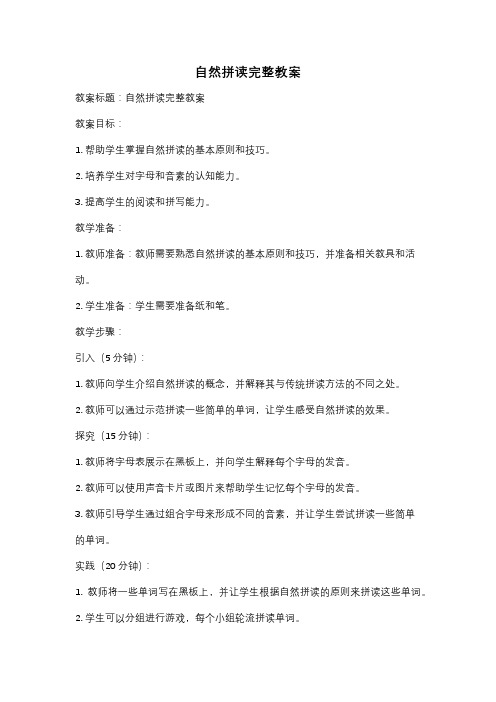
自然拼读完整教案教案标题:自然拼读完整教案教案目标:1. 帮助学生掌握自然拼读的基本原则和技巧。
2. 培养学生对字母和音素的认知能力。
3. 提高学生的阅读和拼写能力。
教学准备:1. 教师准备:教师需要熟悉自然拼读的基本原则和技巧,并准备相关教具和活动。
2. 学生准备:学生需要准备纸和笔。
教学步骤:引入(5分钟):1. 教师向学生介绍自然拼读的概念,并解释其与传统拼读方法的不同之处。
2. 教师可以通过示范拼读一些简单的单词,让学生感受自然拼读的效果。
探究(15分钟):1. 教师将字母表展示在黑板上,并向学生解释每个字母的发音。
2. 教师可以使用声音卡片或图片来帮助学生记忆每个字母的发音。
3. 教师引导学生通过组合字母来形成不同的音素,并让学生尝试拼读一些简单的单词。
实践(20分钟):1. 教师将一些单词写在黑板上,并让学生根据自然拼读的原则来拼读这些单词。
2. 学生可以分组进行游戏,每个小组轮流拼读单词。
3. 教师可以给予学生反馈和指导,帮助他们纠正发音和拼写错误。
巩固(10分钟):1. 教师提供一些练习题,让学生在纸上进行拼读和拼写练习。
2. 学生可以自主完成练习,并互相检查和纠正。
3. 教师可以选择一些学生展示他们的练习成果,并给予肯定和鼓励。
总结(5分钟):1. 教师对本节课的内容进行总结,并强调自然拼读的重要性和优势。
2. 教师鼓励学生在日常学习中继续运用自然拼读的技巧。
拓展活动:1. 学生可以选择一篇短文,用自然拼读的方法来阅读和理解。
2. 学生可以编写一些自然拼读的练习题,与同学互换并互相挑战。
评估方法:1. 教师可以观察学生在课堂上的表现,包括拼读和拼写的准确性。
2. 教师可以给学生布置一些作业,检查他们对自然拼读的理解和应用能力。
自然拼读法教案[五篇]
![自然拼读法教案[五篇]](https://img.taocdn.com/s3/m/01ec2ea2900ef12d2af90242a8956bec0975a59a.png)
自然拼读法教案[五篇]第一篇: 自然拼读法教案自然拼音法(Phonics)教案第一节:1)先来认识26个字母所代表的发音A aB bC cD dE eF fG gH h L l J j K k L l M m N n O o P p Q q R r S s T t U u V v W w X x Y y Z z 2)认识5个元音字母与21个辅音字母。
五个元音字母(a, e, i, o, u), 每个发两种音: 长音(其字母音)和短音, y不在单词开头时, 一般被看做元音字母发音——字母组合发音——单词发音层层递进, 简单易学第二节:短元音 a e i o u 的发音规律※如果一个英语单词或音节里只有一个元音, 且元音不在末尾, 这个元音一般发短音.1)短元音: a [æ]: bag cat mat map apple bat hat fan hand Stan happy 2)短元音: e [e] egg well red pen net hen bed bell best 3)短元音: i [i] lick six bib pig pin kiss ink hill 4)短元音: o [ɔ] pot ox top dog fox box lost top5)短元音: u [ʌ] sun umbrella cup bus nut gun uncle under ※y在末尾(作为元音处理):1)单音节词, 没有其他元音, y发[ai] y [ai]: my, why, fly spy sky shy cry my type dry 2)多音节词, y发[i]y [ i ] puppy dirty rainy sunny happy baby dizzy pony ey [ i ] monkey turkey jockey donkey key hockey money ※如果一个单词或音节里只有一个元音,而且元音在末尾, 这个元音一般发长音(其字母音)如: me, she,hi, go, baby, table, we e he me she we o go a baby table i hi 第三节:一个单词或音节里有两个元音时, 一般来说, 前边一个元音发长音(其字母音), 后边一个元音不发音.长元音1:Magic E(神奇的E)a-e, e-e, i-e, o-e, u-e 发音规律1)长元音: [ei]: a-e space cake snake lake plane name whale grape cage(café)2)长元音: [i:] e-e these Japanese Chinese 3)长元音: [ai] i-e bite five nine kite mine nice ride side 4)长元音: [əu] o-e rose nose rope note pose home rode those 5)长元音: [ju:] u-e tube cube June cute huge 第四节:长元音2: ai ay ee ea ie igh oa ow oe ui ue发音规律 ai [ei] : paint pain tail rain nail maid jail rail ay[ei]:ray say bay way hay lay may payee[i:] : bee peel reeds eel see teeth jeep feet ea[i:] : peanut meat eagle sea leaf pea peach tea ie[ai] : tie pie lie die igh[ai]: ight sight night tight light sigh fight high oa [ou] : coat toast road boat coal goat toad soap ow [ou] :yellow pillow row rainbow bowl window hollow low oe[ou]: doe, hoe, toe ui [ju:] : suit juice fruit ue[ju:] : blue glue sue 第五节带元音的特殊读法or ar ur ir er ear er发音规律※or[ɔ:]:pork porch horse horn corn fork morning ※or[ə:]:work worm world ar[a:]:arm card arm car cart park garden farm ur[ə:]:hurt turkey turtle surfing nurse purse fur ir[ə:]:birthday circus dirty bird circle dirt girl er[ə:]:mermaid term her nerd serve ear[ə:]:learn earn earth heard er[ə]:sister brother marker rooster under mother winter 第六节带元音的特殊读法单元音au aw oo ea all发音规律au[ɔ:]:august sausage sauce naughty autumn applause aw[ɔ:]:saw paw draw strawberry straw lawn oo[u:]:moon zoo roof rooster spoon room boots food oo[u]:book cookie woods wool hook look foot cook ea[e]:head sweater sweat leather feather lead all[ɔ:]: wall fall ball call tall第七节带元音的特殊读法双元音ou ow oi oy ew 发音规律ou [au] mouth out house count shout mouse ow [au]:clown cow owl towel flower tower crown brown oi [ɔi]:coin oil point noise poisoncoil boil soil oy [ɔi]:oyster boy soy toyew [ju:]:new nephew newspaper few dew view第八节带元音的特殊读法双元音 are air ire ear eer 发音规律 are [ɛə] : care share scare dare air[ɛə]: hair air repair ire [aiə]: fire wire ear[iə]: near tear dear clear year hear eer[iə] : deer beer cheers engineer pioneer volunteer 第九节辅音字母组合构成的一种单音1.ch sh wh ph th kn wr 发音规律ch[ʧ] :beach lunch cheese bench chair cherry church chicken sh[ʃ]:sheep shirt ship fish shoes dish pushwh[w]:wheel white whale wheat wheel whisper whip whistle ph [f]:elephant photo telephone th[ð]:brother feather leather father mother(舌头放在上下牙之间, 然后迅速收回, 此音一般在单词的中间, 后接元音)th[θ]:thumb bathmat three thirsty mouth teeth thief bath 舌头放在上下牙之间, 不动, 让其留从舌尖滑过, 此音一般放在单词的开头或最后, 属于气音。
Lesson1自然拼读课件通用版小学英语

Lesson1自然拼读课件通用版小学英语一、教学内容二、教学目标1. 让学生掌握元音字母a、e、i、o、u的基本发音,并能在实际情境中运用。
2. 培养学生运用自然拼读法拼读和识记单词的能力。
3. 提高学生的英语学习兴趣,培养合作学习和自主学习的能力。
三、教学难点与重点教学难点:元音字母在单词中的发音规律,以及自然拼读法的运用。
教学重点:元音字母a、e、i、o、u的基本发音,以及相关单词的拼读和识记。
四、教具与学具准备1. 教具:PPT课件、单词卡片、录音机、磁带。
2. 学具:学生用书、练习本、彩笔。
五、教学过程1. 导入:通过PPT展示一个有趣的英语故事,让学生在听故事的过程中感受英语发音的魅力,激发学习兴趣。
过程细节:教师播放PPT,引导学生关注故事中的元音字母发音,让学生尝试模仿。
2. 讲解:讲解元音字母a、e、i、o、u的发音规律,结合教材实例进行示范。
过程细节:教师通过PPT展示发音规则,引导学生观察和模仿,并进行个别指导。
3. 实践:分组进行自然拼读练习,让学生在实际操作中掌握发音规律。
过程细节:教师发放单词卡片,学生分组进行拼读练习,教师巡回指导。
4. 互动:进行小组竞赛,看哪个小组能在最短时间内正确拼读出更多单词。
过程细节:教师设置时间限制,学生积极参与,教师点评并给予奖励。
六、板书设计1. 板书Lesson1 自然拼读法之元音字母发音2. 板书内容:(1)元音字母a、e、i、o、u的发音规律(2)自然拼读法的基本步骤(3)相关单词示例七、作业设计1. 作业题目:(3)模仿教材中的例子,自己编写一个含有元音字母的单词,并注明其发音。
2. 答案:(1)cat, dog, fish, bird, sun(2)/mæp/, /pen/, /kʌp/, /bɛd/, /ɛɡ/(3)示例:star(/stɑr/)八、课后反思及拓展延伸1. 课后反思:关注学生在课堂上的参与度,了解学生对元音字母发音规律的掌握程度,及时调整教学策略。
Lesson1自然拼读课件通用版小学英语
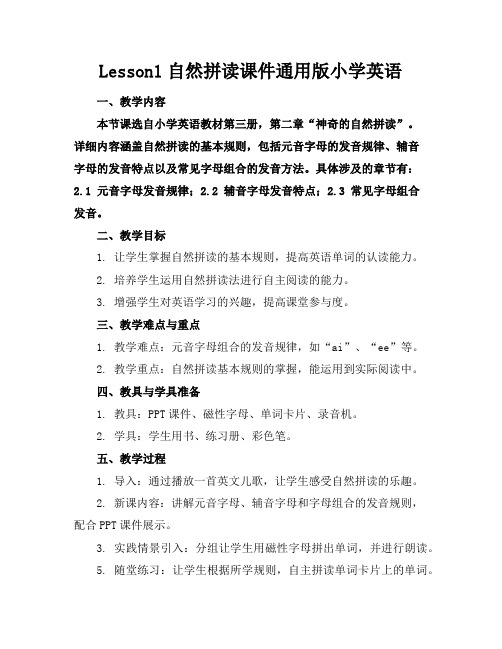
Lesson1自然拼读课件通用版小学英语一、教学内容本节课选自小学英语教材第三册,第二章“神奇的自然拼读”。
详细内容涵盖自然拼读的基本规则,包括元音字母的发音规律、辅音字母的发音特点以及常见字母组合的发音方法。
具体涉及的章节有:2.1 元音字母发音规律;2.2 辅音字母发音特点;2.3 常见字母组合发音。
二、教学目标1. 让学生掌握自然拼读的基本规则,提高英语单词的认读能力。
2. 培养学生运用自然拼读法进行自主阅读的能力。
3. 增强学生对英语学习的兴趣,提高课堂参与度。
三、教学难点与重点1. 教学难点:元音字母组合的发音规律,如“ai”、“ee”等。
2. 教学重点:自然拼读基本规则的掌握,能运用到实际阅读中。
四、教具与学具准备1. 教具:PPT课件、磁性字母、单词卡片、录音机。
2. 学具:学生用书、练习册、彩色笔。
五、教学过程1. 导入:通过播放一首英文儿歌,让学生感受自然拼读的乐趣。
2. 新课内容:讲解元音字母、辅音字母和字母组合的发音规则,配合PPT课件展示。
3. 实践情景引入:分组让学生用磁性字母拼出单词,并进行朗读。
5. 随堂练习:让学生根据所学规则,自主拼读单词卡片上的单词。
7. 作业布置:布置课后作业,巩固所学知识。
六、板书设计1. Lesson1 自然拼读课件通用版2. 内容:元音字母、辅音字母、字母组合的发音规则3. 示例:单词“cat”、“dog”的自然拼读法七、作业设计1. 作业题目:2. 答案:(1)ship:/ʃɪp/;bed:/bed/;sun:/sʌn/;hill:/hɪl/(2)fish:/fɪʃ/;tree:/tri:/;house:/haʊs/;box:/bɒks/八、课后反思及拓展延伸1. 反思:关注学生在课堂上的参与度,针对不同学生的学习情况,调整教学方法和节奏。
2. 拓展延伸:鼓励学生在课后阅读英文绘本,运用自然拼读法进行自主阅读,提高英语水平。
同时,教师可提供相关资源,如音频、视频等,帮助学生更好地进行拓展学习。
Lesson1自然拼读优质课件通用版小学英语

Lesson1自然拼读优质课件通用版小学英语一、教学内容本节课选自小学英语教材第三章,主题为“自然拼读”。
详细内容包括元音字母a, e, i, o, u及其短元音发音规则,辅音字母b, c, d, f, g等在单词中的发音,以及相关的单词和短语拼读练习。
二、教学目标1. 让学生掌握元音字母及其短元音的发音规则,并能准确拼读相关单词。
2. 让学生熟悉辅音字母在单词中的发音,提高单词识别和拼写能力。
3. 培养学生的英语语感,激发他们对英语学习的兴趣。
三、教学难点与重点1. 教学难点:元音字母及其短元音发音规则的掌握,以及辅音字母在单词中的发音。
2. 教学重点:单词拼读、拼写,以及相关发音规则的运用。
四、教具与学具准备1. 教具:PPT课件、单词卡片、录音机、磁带等。
2. 学具:学生用书、练习册、彩色笔等。
五、教学过程1. 导入:通过唱英文歌谣,引入元音字母和辅音字母的概念,激发学生学习兴趣。
2. 呈现:使用PPT课件,展示元音字母及其短元音发音规则,辅音字母在单词中的发音,并进行讲解。
3. 实践:让学生分组,根据所学规则拼读单词,并进行角色扮演,巩固知识。
4. 例题讲解:结合教材,讲解典型例题,引导学生运用所学规则进行拼读。
5. 随堂练习:发放练习册,让学生完成相关练习,检验学习效果。
六、板书设计1. 板书Lesson1 自然拼读2. 内容:元音字母及其短元音发音规则辅音字母在单词中的发音相关单词及短语七、作业设计1. 作业题目:2. 答案:cat: /k æ t/dog: /d ɒ g/fish: /fɪʃ/bird: /bɜːd/sun: /sʌn/moon: /muːn/sky: /skaɪ/run: /rʌn/jump: /dʒʌmp/play: /pleɪ/bat: /bæt/fat: /fæt/hat: /hæt/mat: /mæt/sit: /sɪt/bit: /bɪt/pig: /pɪg/dig: /dɪg/big: /bɪg/八、课后反思及拓展延伸2. 拓展延伸:鼓励学生课后阅读英语绘本,提高英语阅读能力。
(完整)自然拼读法的教案1

自然拼读法教案第一课时:一、先用5分钟简单地介绍:1、什么是自然拼读?所有的单词都是由26个字母拼出来的,了解和学习英语字母组合的奥妙,掌握英语拼读规律。
学生一旦掌握了这种方法,按照拼读规律能够写出该单词。
2、为什么要学习自然拼读?自然拼读的好处是见词能读、见词敢读,听到读音,就敢拼写。
二、21个辅音字母的发音。
第二课时:一、将21个辅音字母按规律分类:第一类:掐头法(6个)f[ef] l[el] m[em] n[en] s[es] x[eks]第二类:去尾法(8个)b[bi:] d[di:] p[pi:] t[ti:] v[vi:] z[zi:] j[dʒei] k[kei] 第三类:对比法(7个)发音与字母本身区别有点大,跟汉语拼音有点像。
h[h] r[r] w[w]y[j] c[k] g[g]q qu[kw](q胆小,通常与u一起出现发[kw])二、辅音字母基础发音练习帽子hat[h æt]老鼠rat[r æt]猫cat[k æt] 酒桶vat[v æt]平板电脑pad[p æ d ] 实验室lab[l æ b] 传真机fax[f æ x]毛牛yak[y æ k]果酱jam[dʒæ m]呱呱叫quack[qw æ k]天鹅swan[sw æ n] Z字形zag[z æ g]熟读这12个单词就基本掌握了21个辅音的读法。
第三课时:五个元音字母的短音和长音a:短音[æ]:当一个单词或音节里只有一个元音a时读作短音.例:ant, and,cat, fast, map,dad,sada:长音[ei]而当这个单词或音节后面加上字母e时,读作长音。
例:cake,name,face,make,game,plane,wave,bakee:短音:[e]当一个单词或音节里只有一个元音e读作短音。
2024年小学一自然拼读教案

2024年小学一自然拼读教案一、教学内容本节课选自《小学英语一年级》教材,具体章节为“Unit 1自然拼读基础”,详细内容包括字母AaBb的发音及书写,元音与辅音的结合,以及简单的拼读练习。
二、教学目标1. 让学生掌握字母AaBb的发音及书写,了解自然拼读的基本规律。
2. 培养学生运用自然拼读法拼读单词的能力。
三、教学难点与重点难点:字母AaBb的发音及书写,元音与辅音的结合。
重点:自然拼读法的运用。
四、教具与学具准备教师准备:字母卡片、单词卡片、教学录音机、黑板、粉笔。
学生准备:练习本、铅笔、橡皮。
五、教学过程1. 实践情景引入(5分钟)教师与学生进行简短的互动,询问学生喜欢的水果,如“Do you like apples?”并引导学生用“Yes, I do.”或“No, I don't.”回答。
2. 新课内容展示(15分钟)教师展示字母AaBb的卡片,引导学生学习字母的发音及书写。
通过举例,让学生了解元音与辅音的结合。
3. 例题讲解(10分钟)教师给出几个单词,如“apple、banana、boy”,带领学生用自然拼读法拼读,并解释每个字母的发音。
4. 随堂练习(10分钟)学生两人一组,互相拼读单词,巩固所学内容。
5. 小组竞赛(10分钟)教师将学生分成小组,进行拼读竞赛,鼓励学生积极参与,提高课堂氛围。
六、板书设计1. 字母AaBb的书写示范2. 元音与辅音结合的例子3. 拼读练习单词七、作业设计2. 答案:cat(/k æ t/)、dog(/d ɒ g/)、fish(/fɪʃ/)、bird(/bɜːrd/)、egg(/eɡ/)。
八、课后反思及拓展延伸1. 反思:关注学生对字母发音及拼读的掌握情况,针对学生的薄弱环节进行针对性教学。
2. 拓展延伸:引导学生学习其他字母的发音及拼读,增加词汇量,提高英语水平。
重点和难点解析1. 字母AaBb的发音及书写2. 元音与辅音的结合3. 自然拼读法的运用4. 课后作业设计详细补充和说明:一、字母AaBb的发音及书写1. 发音:教师要准确地示范字母的发音,注意发音的清晰度和准确性。
英语自然拼读教案

英语自然拼读教案
教学目标:
1. 学生能够理解和运用英语自然拼读规则,正确读音单词。
2. 学生能够通过自然拼读的方法正确地拼写单词。
3. 学生能够在理解和运用自然拼读规则的基础上,增强对英语单词的拼写能力。
教学过程:
一、导入:
教师将一些简单的单词卡片分发给学生,并要求学生用自然拼读的方法读出单词。
二、呈现:
1. 教师将自然拼读规则的海报贴在黑板上,向学生解释什么是自然拼读,以及自然拼读规则的重要性。
同时,教师会逐一介绍和说明每个自然拼读规则的用法和示例单词,并要求学生跟读和模仿。
2. 在黑板上列举一些单词,例如:cat, dog, sun, run等,要求学生根据自然拼读规则读出这些单词,并解释规则的适用性。
三、巩固:
1. 教师向学生出示一张图片,例如:a cup,然后教师会念出"cup"的发音,要求学生根据自然拼读规则拼写出"cup"的字母并写在纸上。
2. 教师将学生的纸互相交换,要求学生阅读他人的拼写并进行矫正。
四、拓展:
教师出示更多的单词和图片,要求学生根据自然拼读规则进行拼写,并进行互相检查和纠正。
五、总结:
教师对自然拼读规则再次进行总结,强调规则的重要性和应用。
要求学生复述并归纳自然拼读规则和应用方法。
六、作业:
要求学生以自然拼读的方法完成一篇课文的阅读,并写出不会拼读的单词交作业。
自然拼读Unit1教案word版本

自然拼读Unit1教案Lesson type Unit1teacher YuRanNew prouncation Aa/æ/Bb/b/ ,Cc/k/ ,Dd/d/ ,Ee/e/,Ff/f/,Gg/g/,Hh/h/,Ii/i/,Jj/dʒ/,Kk/k/,Ll/l/,Mm/m/,Nn/n/,O o/ɒ/,Pp/p/,Qq/kw/,Rr/r/,Ss/s/,Tt/t/,Uu/ʌ/,Vv/v/,Ww/w/,Xx/ks/,Yy/j/,Zz/z/New words Apple,book,cat,dog,elephant,fork,goose,hat,Indian,juice,kitchen,lemon,monkey,n urse,octopus,pen,queen,rabbit,sea,teacher,uncle,vase,window,fox,yellow,zebra Teaching keys5 vowel:Aa Ee Ii Oo Uu 及它们的发音:长元音/a:/ /ɜ: / /i:/ /ɔ: / /u:/;短元音:/æ/ /e/ /i/ /ʌ / /u/一.Opening andReview听说读写1.2.3.Greeting: Hello, boys and girls,I’m glad to see you again. How are you?How are you going on during your Spring Festival?What day is it today? Are you happy?4.Roll call: Now this time, let's have a roll call .when I call your name, you should stand up and say here .5.6.Review: Now let’s sing a song together<<Blue,blue......>>,Pretty good,Let,s do the letter exercises together,everybody please stant up.,二New words教学目标:掌握26个字母发音及对应单词的拼读。
自然拼读教案L1_U2_Lesson Plan
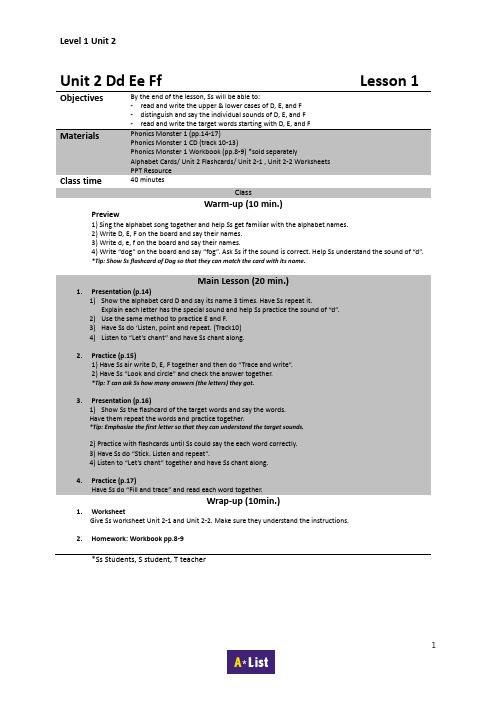
Unit 2 Dd Ee Ff Lesson 1 Objectives By the end of the lesson, Ss will be able to:-read and write the upper & lower cases of D, E, and F-distinguish and say the individual sounds of D, E, and F-read and write the target words starting with D, E, and FMaterials Phonics Monster 1 (pp.14-17)Phonics Monster 1 CD (track 10-13)Phonics Monster 1 Workbook (pp.8-9) *sold separatelyAlphabet Cards/ Unit 2 Flashcards/ Unit 2-1 , Unit 2-2 WorksheetsPPT ResourceClass time40 minutesClassWarm-up (10 min.)Preview1)Sing the alphabet song together and help Ss get familiar with the alphabet names.2)Write D, E, F on the board and say their names.3)Write d, e, f on the board and say their names.4)Write “dog” on the board and say “fog”. Ask Ss if the sound is correct. Help Ss understand the sound of “d”.*Tip:Show Ss flashcard of Dog so that they can match the card with its name.Main Lesson (20 min.)1.Presentation (p.14)1)Show the alphabet card D and say its name 3 times. Have Ss repeat it.Explain each letter has the special sound and help Ss practice the sound of “d”.2)Use the same method to practice E and F.3)Have Ss do ‘Listen, point and repeat. (Track10)4)Listen to “Let’s chant” and have Ss chant along.2.Practice (p.15)1)Have Ss air write D, E, F together and then do “Trace and write”.2)Have Ss “Look and circle” and check the answer together.*Tip: T can ask Ss how many answers (the letters) they got.3.Presentation (p.16)1)Show Ss the flashcard of the target words and say the words.Have them repeat the words and practice together.*Tip: Emphasize the first letter so that they can understand the target sounds.2)Practice with flashcards until Ss could say the each word correctly.3)Have Ss do “Stick. Listen and repeat”.4)Listen to “Let’s chant” together and have Ss chant along.4.Practice (p.17)Have Ss do “Fill and trace” and read each word together.Wrap-up (10min.)1.WorksheetGive Ss worksheet Unit 2-1 and Unit 2-2. Make sure they understand the instructions.2.Homework: Workbook pp.8-9*Ss Students, S student, T teacherUnit 2 Dd Ee Ff Lesson 2Objectives By the end of the lesson, Ss will be able to:-distinguish and say the individual sounds of D, E, and F-read the target words starting with D, E, and F-read the following sight words: the, to-read sentences including the phonics words and the sight wordsMaterials Phonics Monster 1 (pp.18-21)Phonics Monster 1 CD (track 14-16)Phonics Monster 1 Workbook (pp.10-11) *sold separately Alphabet Cards/ Unit 2 Flashcards/ Unit 2-3 Worksheets PPT ResourceClass time 40 minutesClassWarm-up (10 min.)Review1)Write D, E, F on the board and say their names.2)Write d, e, f on the board and say their names.3)Write “elephant” on the board and say /i/ / lɪfənt/ emphasizing the letter “e”.Have Ss say the correctsound. Help Ss understand the letters in words.Main Lesson (20 min.)1.Presentation1)Practice the target words using flashcards. Show the pictures first and then flip the cards to show thewords. Have Ss say the words.2)Practice until Ss could say all the words correctly.2.Practice (p.18)1)Have Ss do “Listen, Point and say.”2)Have Ss do “Say and check” and check the answers together.3.Presentation (p.19)1)Picture Walk Activity:T says the following while pointing each picture.“Everyone is hungry so they are heading to the food.”“Look at the dog. The dog is heading to the desk.”“How about elephant? The elephant is heading to the egg.”“Look! The fox is heading to the five fish.”*Tip: This is an activity to help Ss read the words they’ve learned in a sentence format.Help Ss to connect the pictures with the story to help them have confidence in reading.2)Write the following sight words on the board and read them: the, to. Repeat the words 3 times.3)Have Ss “Find & Circle”.4)Reading Activity-Have Ss do “Stick. Listen and repeat.”-Read aloud the sentences together.*Tip: Have Ss read in small groups to check if there is any S who has difficulty reading it.5)Unit Master (p.20-21)-Have Ss do “Listen and circle.” (Track 16)-Have Ss do “Say, color and write.”-Have Ss do “Find and circle. Then write.”-Point the picture of the target word and have Ss say the word.Wrap-up (10min.)1.WorksheetGive Ss worksheet Unit 2-3 and check if they understand how to do it.2.Homework: Workbook pp10-11*Ss Students, S student, T teacherUnit 2 Phonics Reader: I Am HungryObjectives By the end of the lesson, Ss will be able to:-read and write the following words: dog, duck, egg, elephant, fish, fox -read the following sight words: after, am, I, is-read and understand the storyMaterials Phonics Reader 1 (pp9-13) Phonics Monster 1 CD (track 67-68) Unit 2 FlashcardsPPT ResourceClass time 40 minutesClassWarm-up (10 min.)1.Presentation (p.9)1)Phonics Words-Write d, e, f on the board and check if Ss can say their names and the sounds.-Practice the Phonics Words using flashcards. Make sure they read them correctly.* Tip: If Ss cannot read the words fluently, practice more before reading the story.2)Sight Words-Write the following sight words on the board: after, am, I, is-Have Ss repeat the words and explain what each word means.Main Lesson (20 min.)1.Prediction (pp.9-13)1)Ask Ss what the title is. “What is the title?”2)Picture Walk-p.10 “What is the dog doing? Yes, the dog is running. What is the dog after?-p.11 “Look, the elephant is also running. What is the elephant after?-p.12 “The fox is swimming. What is the fox after?”-p.13 “Oh, no! There’s a monster. The monster looks hungry.”2.Read (pp.10-13)1)Listen to the whole story (Track 67). Have Ss point to the words as they listen.2)Read aloud the story together. Have Ss read in small groups.prehension (pp.10-13)1)Give 3 minutes for Ss to read the story on their own.2)Have Ss close the book and read the story without some words (target words).Have Ss say the correct word in blanks.*Tip: T can show the blanks by saying the certain sound or clapping.Wrap-up (10min.)prehension Check (p.14)1)Have Ss do “Fill and trace.”2)Have Ss read the sentences out loud.2.Song. (Track 68)Listen to the CD and sing along.3.Homework: Listen to “Unit 2 I Am Hungry.” 3 times and repeat 3 times.*Ss Students, S student, T teacher。
最新自然拼读Unit1教案
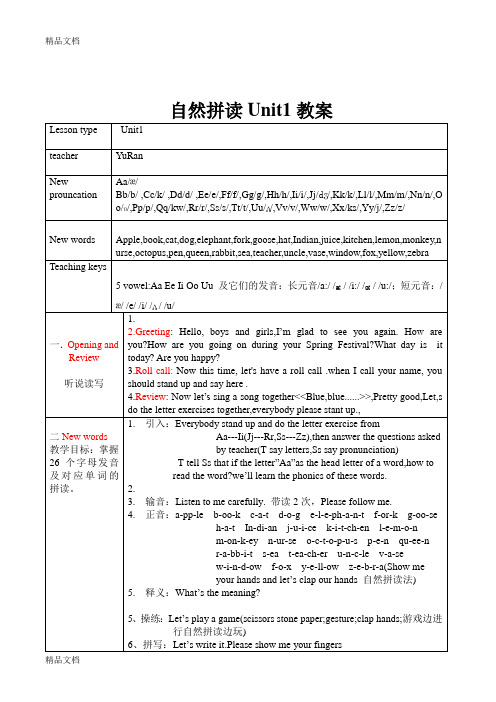
2.
3.众上所述,我们认为:我们的创意小屋计划或许虽然会有很多的挑战和困难,但我们会吸取和借鉴“漂亮女生”和“碧芝”的成功经验,在产品的质量和创意上多下工夫,使自己的产品能领导潮流,领导时尚。在它们还没有打入学校这个市场时,我们要巩固我们的学生市场,制作一些吸引学生,又有使学生能接受的价格,勇敢的面对它们的挑战,使自己立于不败之地。输音:Listen to me carefully.带读2次,Please follow me.
3.Roll call:Now this time, let's have a roll call .when I call your name, you should stand up and say here .
4.Review: Now let’s sing a song together<<Blue,blue......>>,Pretty good,Let,s do the letter exercises together,everybody please stant up.,
1.
2.随科技的迅速发展,人们的生活日益趋向便捷、快速,方便,对于我国传统的手工艺制作,也很少有人问津,因此,我组想借此创业机会,在校园内开个DIY创意小屋。它包括编织、刺绣、串珠等,让我们传统的手工制作也能走进大学,丰富我们的生活。Greeting: Hello, boys and girls,I’m glad to see you again. How are you?How are you going on during your Spring Festival?What day isittoday? Are you happy?
自然拼读 第一课
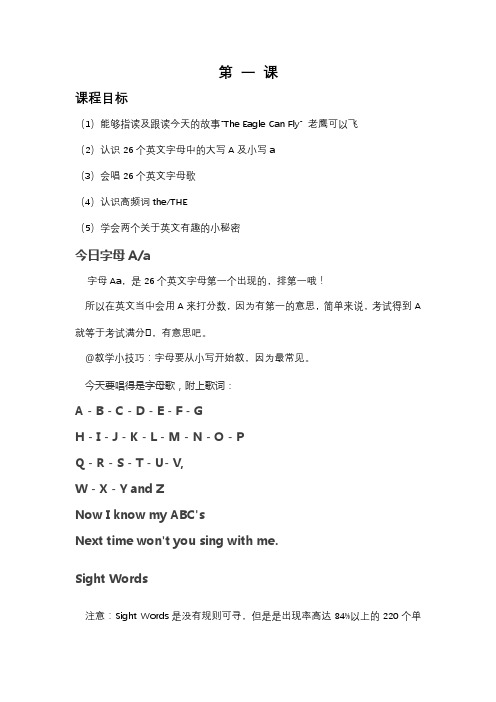
第一课课程目标(1)能够指读及跟读今天的故事“The Eagle Can Fly” 老鹰可以飞(2)认识26个英文字母中的大写A及小写a(3)会唱26个英文字母歌(4)认识高频词the/THE(5)学会两个关于英文有趣的小秘密今日字母A/a字母Aa,是26个英文字母第一个出现的,排第一哦!所以在英文当中会用A来打分数,因为有第一的意思,简单来说,考试得到A 就等于考试满分 ,有意思吧。
@教学小技巧:字母要从小写开始教,因为最常见。
今天要唱得是字母歌,附上歌词:A -B -C -D -E -F - GH - I - J - K - L - M - N - O - PQ - R - S - T - U- V,W - X - Y and ZNow I know my ABC'sNext time won't you sing with me.Sight Words注意:Sight Words是没有规则可寻,但是是出现率高达84%以上的220个单字。
英语学习基本功=自然拼读+Sight Words今天要学习的的Sight wrods 是出现频率高达90%的"THE/the"。
the 是什么意思呢?the 在中文里面正式的说法是[冠词]。
冠词是做什么的呢?冠词就是帮助名词在句子中变完整,让句子听起来更顺耳;就像吃冰激凌已经很棒了,要是再加上香浓巧克力酱就能够让冰激凌更顺口一样,the 就是扮演吃冰激凌中巧克力酱的角色。
在那么多的英文中只有三个冠词,分别是the、a跟an。
@伴读小技巧:不要认为学龄前的孩子还小就过度简化他们本来应该要学习得常识,只需要把新的事物与他们认知范围内可以对比的串联起来,他们就能够理解。
@教学小技巧:教孩子们文法要从小开始,用说故事的比喻法让孩子慢慢累积,才能够孰能生巧又没有压力。
在告诉孩子英文中的三个冠词分别是the、a跟an过程中中,这里的教学重点不是这3个字,而是数字3。
牛津英语自然拼读教学第一册第一课教学流程
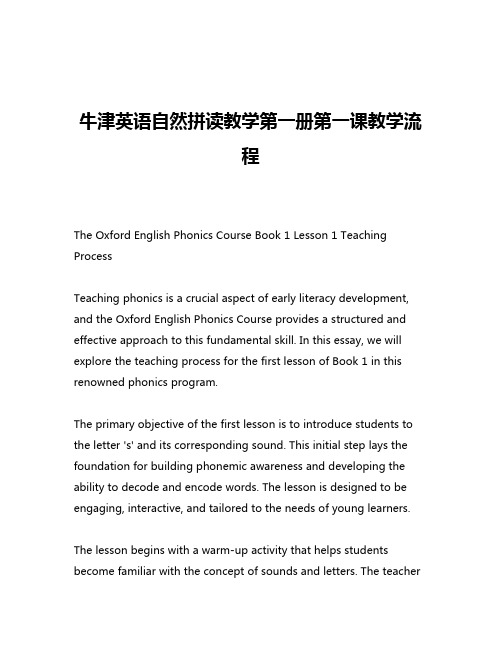
牛津英语自然拼读教学第一册第一课教学流程The Oxford English Phonics Course Book 1 Lesson 1 Teaching ProcessTeaching phonics is a crucial aspect of early literacy development, and the Oxford English Phonics Course provides a structured and effective approach to this fundamental skill. In this essay, we will explore the teaching process for the first lesson of Book 1 in this renowned phonics program.The primary objective of the first lesson is to introduce students to the letter 's' and its corresponding sound. This initial step lays the foundation for building phonemic awareness and developing the ability to decode and encode words. The lesson is designed to be engaging, interactive, and tailored to the needs of young learners.The lesson begins with a warm-up activity that helps students become familiar with the concept of sounds and letters. The teachermay start by asking students to share words that begin with the sound 's,' encouraging them to think of examples from their everyday lives. This activates prior knowledge and piques their interest in the topic.Next, the teacher introduces the letter 's' using a multi-sensory approach. This may involve displaying a large, colorful image of the letter, tracing it in the air, and having students trace it with their fingers on the desk or in a sand tray. The teacher then models the correct pronunciation of the 's' sound, emphasizing the articulation and encouraging students to listen carefully.To reinforce the connection between the letter and its sound, the teacher presents a variety of words that begin with 's.' These words can be displayed on flashcards, written on the board, or projected onto a screen. Students are asked to identify the initial sound in each word and to repeat the words, focusing on the 's' sound.The lesson then transitions to interactive activities that allow students to actively engage with the new learning. One such activity might be a game where students sort objects or pictures into two categories: those that begin with 's' and those that do not. This hands-on exercise helps solidify the students' understanding of the target sound and letter.Another engaging activity could be a listening exercise where the teacher reads a series of words, and students raise their hands or move a marker whenever they hear a word that begins with 's.' This activity not only reinforces the 's' sound but also develops students' phonemic awareness skills.To further cement the learning, the teacher may introduce simple, decodable words that contain the 's' sound, such as 'sat,' 'sun,' and 'sip.' Students are encouraged to read these words aloud, practicing their newly acquired skills in blending sounds to form words.Throughout the lesson, the teacher provides frequent feedback and praise, celebrating students' successes and guiding them through any challenges. This positive reinforcement helps build students' confidence and fosters a love of learning.The lesson concludes with a review of the key concepts covered, such as the letter 's,' its corresponding sound, and the words that begin with 's.' Students may be asked to share what they have learned or to complete a simple assessment activity, such as circling the 's' words in a list.By following this structured and engaging teaching process, the Oxford English Phonics Course Book 1 Lesson 1 lays a solid foundation for students' phonics development. The multisensoryapproach, interactive activities, and positive reinforcement create an environment that supports the diverse learning needs of young students. As they progress through the course, students will continue to build upon this initial lesson, developing their phonemic awareness, decoding skills, and overall literacy proficiency.。
- 1、下载文档前请自行甄别文档内容的完整性,平台不提供额外的编辑、内容补充、找答案等附加服务。
- 2、"仅部分预览"的文档,不可在线预览部分如存在完整性等问题,可反馈申请退款(可完整预览的文档不适用该条件!)。
- 3、如文档侵犯您的权益,请联系客服反馈,我们会尽快为您处理(人工客服工作时间:9:00-18:30)。
6、拼写:Let’s write it.Please show 以下918%7、输出:Read it one by one;Catch the fingers
8、总输出:Read“Aa---Zz’’ after teacher;Read it together.
5.释义:What’s the meaning?
市场环境所提供的创业机会是客观的,但还必须具备自身的创业优势,才能使我们的创业项目成为可行。作为大学生的我们所具有的优势在于:5、操练:Let’s play a game(scissors stone paper;gesture;clap hands;游戏边进行自然拼读边玩)
T tell Ss that if the letter”Aa”as the head letter of a word,how to read the word?we’ll learn the phonics of these words.
2.
3.众上所述,我们认为:我们的创意小屋计划或许虽然会有很多的挑战和困难,但我们会吸取和借鉴“漂亮女生”和“碧芝”的成功经验,在产品的质量和创意上多下工夫,使自己的产品能领导潮流,领导时尚。在它们还没有打入学校这个市场时,我们要巩固我们的学生市场,制作一些吸引学生,又有使学生能接受的价格,勇敢的面对它们的挑战,使自己立于不败之地。输音:Listen to me carefully.带读2次,Please follow me.
功能性手工艺品。不同的玉石具有不同的功效,比如石榴石可以促进血液循环,改善风湿和关节炎;白水晶则可以增强记忆力;茶晶能够帮助镇定情绪,缓解失眠、头昏等症状。顾客可以根据自己的需要和喜好自行搭配,每一件都独一无二、与众不同。New words
加拿大beadworks公司就是根据年轻女性要充分展现自己个性的需求,将世界各地的珠类饰品汇集于“碧芝自制饰品店”内,由消费者自选、自组、自制,这样就能在每个消费者亲手制作、充分发挥她们的艺术想像力的基础上,创作出作品,达到展现个性的效果。Apple,book,cat,dog,elephant,fork,goose,hat,Indian,juice,kitchen,lemon,monkey,nurse,octopus,pen,queen,rabbit,sea,teacher,uncle,vase,window,fox,yellow,zebra
(5)资金问题二New words
教学目标:掌握26个字母发音及对应单词的拼读。
1.引入:Everybody stand up and do the letter exercise from Aa---Ii(Jj---Rr,Ss---Zz),then answer the questions asked by teacher(T say letters,Ss say pronunciation)
三Rule Breakers
1、Teacher have a summary of the pronunciations of Aa,Oo,Ss,Uu
2、T带读2次(每个单词)
3.Roll call:Now this time, let's have a roll call .when I call your name, you should stand up and say here .
4.Review: Now let’s sing a song together<<Blue,blue......>>,Pretty good,Let,s do the letter exercises together,everybody please stant up.,
1.
2.随科技的迅速发展,人们的生活日益趋向便捷、快速,方便,对于我国传统的手工艺制作,也很少有人问津,因此,我组想借此创业机会,在校园内开个DIY创意小屋。它包括编织、刺绣、串珠等,让我们传统的手工制作也能走进大学,丰富我们的生活。Greeting: Hello, boys and girls,I’m glad to see you again. How are you?How are you going on during your Spring Festival?What day isittoday? Are you happy?
自然拼读Unit1教案
Lesson type
Unit1
teacher
YuRan
New prouncation
Aa/æ/ Bb/b/ ,Cc/k/ ,Dd/d/ ,Ee/e/,Ff/f/,Gg/g/,Hh/h/,Ii/i/,Jj/dʒ/,Kk/k/,Ll/l/,Mm/m/,Nn/n/,Oo/ɒ/,Pp/p/,Qq/kw/,Rr/r/,Ss/s/,Tt/t/,Uu/ʌ/,Vv/v/,Ww/w/,Xx/ks/,Yy/j/,Zz/z/
Teaching keys
调研课题:5 vowel:Aa Ee Ii Oo Uu及它们的发音:长元音/a:/ /ɜ:/ /i:/ /ɔ:/ /u:/;短元音:/æ/ /e/ /i/ /ʌ/ /u/
标题:手工制作坊2004年3月18日
一.Opening and Review
二、大学生DIY手工艺制品消费分析听说读写
